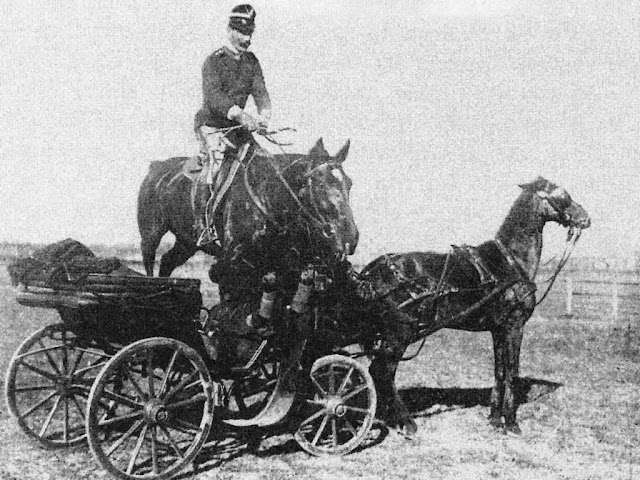 Federico Caprilli was born in Livorno in 1868. He is credited with developing the system for “forward seat” riding. When he became a young cadet in the Italian Cavalry horses were still ridden over obstacles in an extremely restricted manner.
Federico Caprilli was born in Livorno in 1868. He is credited with developing the system for “forward seat” riding. When he became a young cadet in the Italian Cavalry horses were still ridden over obstacles in an extremely restricted manner.Riders were taught to pull and lean back during the jump to make sure the horse's hindlegs would land first to minimise the impact, protecting the supposedly fragile forelegs. Caprilli had been watching horses jumping freely, observing that all of them always and naturally landed on their forelegs.
 The new ideas of the young Lieutenant weren't well accepted at first. He was removed from his duties as a trainer of cavalry units and transferred to Southern Italy as a punishment.
The new ideas of the young Lieutenant weren't well accepted at first. He was removed from his duties as a trainer of cavalry units and transferred to Southern Italy as a punishment.Only a few years later the new ideas were recognised and Caprilli was returned to the cavalry schools in Northern Italy where, after a year of his training, the results where ncredible: the horses were so willing that their riders were able to complete a cavalry training course without reins.
 Following this breakthrough, Caprilli was at last made Chief Riding Instructor of the Italian Cavalry. Soldiers from around the world came to his schools to learn his training system, mostly based on the non-interference of the riders.
Following this breakthrough, Caprilli was at last made Chief Riding Instructor of the Italian Cavalry. Soldiers from around the world came to his schools to learn his training system, mostly based on the non-interference of the riders. Our local horse-racing facility, inaugurated in 1894, was renamed in his honor “Ippodromo Federico Caprilli” in 1937. He died in Pinerolo in 1907, when his horse slipped on icy cobblestones and fell. On his tombstone, this simple epitaph:
Our local horse-racing facility, inaugurated in 1894, was renamed in his honor “Ippodromo Federico Caprilli” in 1937. He died in Pinerolo in 1907, when his horse slipped on icy cobblestones and fell. On his tombstone, this simple epitaph:FRIDERICUS CAPRILLI
MAGISTER EQUITUM
1868 - 1907
(Federico Caprilli
Master of Horsemen
1868 - 1907)
MAGISTER EQUITUM
1868 - 1907
(Federico Caprilli
Master of Horsemen
1868 - 1907)

16 comments:
Interesting history. I love the old photos and the last one too!
What a nice post VP. Thank you for all the info. Great horse racing place.
From where I come from, it is said, 'that the luck of the world, is to be found on the back of a horse.'
Thank you for teaching about him and his history. Please have a good Sunday.
daily athens
Fridericus Caprilli was certainly a fine figure of a man and he sat his horse very well. It was good that his technique for handling horses in a jump was accepted and he was reinstated! He died with his boots on, with his horse! Tragic but fitting!
VP, thank you for another excellent educational post. I know very little about riding horses, but now I know an interesting tale about how horses land from jumps and how a Livorno native changed riding styles to take advantage of that knowledge.
So interesting! I can't even imagine the rider leaning back and the horse landing on hind feet. So glad Caprilli straightened things out and got everyone back to the natural way of jumping (even though he was "punished" in southern Italy).
A fitting end for the Magister Equitum.
Nice to see you have a race track.
And Master he was. How uncomfortable for both horse and rider to jump the old way. MB
A very interesting story!
Excellent vintage photographs, esp. the top!
What an amazing man! This post has made me miss riding :-D
Kaori in Shinjuku
What fascinates me here is it's the same reaction over and over again: you do something new and you are shunned for it. Beautiful post.
Excellent historical perspective.
Totally agree with cieldequimper, not easy to be a pioneer!
God bless you!
Cezar
Really interesting information. Thanks, VP!
How clever of him to notice how horses naturally land when they jump.
Besides the obvious horse story here, I focus on the same as Ciel: the reluctance of humans to accept and even consider change. We are finding this attitude in our world of research were government and NGO institutions are slow to accept clear evidence that counters the prevailing views.
Post a Comment